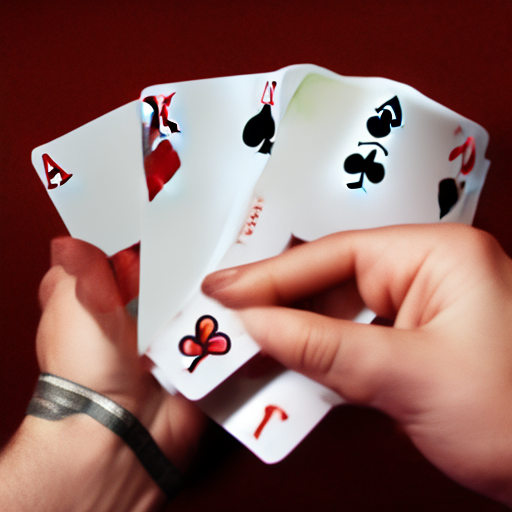Are you looking for the edge over your opponents in poker? If so, mastering the art of bluffing could be the trick you’re looking for. Bluffing is a fundamental part of poker, and there are certain techniques that, when put into play, can give you the upper hand, guaranteeing you success if used correctly. In this article, we’ll explore the tricks of the trade for mastering poker bluffing.
1. What is Bluffing?
Bluffing is an artful way of deceiving others without lying. It’s like playing a role and convincing people to believe in it. One example of bluffing is in poker games when players pretend to have a better hand than what they actually have. This allows them to cause uncertainty and lure their opponents into making bad decisions.
Bluffing is not only limited to card games, it’s a common practice in our daily lives too. Think of a job interview where you may strategically exaggerate your skills to stand out from other candidates. Or when you tell your friends that you’ve seen a particular movie just to fit in with the conversation even though you haven’t. With bluffing, it’s essential to walk the fine line between exaggeration and deception. It’s a powerful skill, but one that requires tact and intuition to master.
2. Mastering Poker Bluffing Tactics
No matter what level of poker player you are, mastering bluffing tactics is crucial if you want to stay ahead of the game. Bluffing in poker means pretending to have a better hand than you really do, in order to make your opponents fold and increase your chances of winning the pot. But it’s important to know when to use this technique, as bluffing at the wrong time can easily backfire and cost you dearly.
To become a master bluffer, you need to first analyze your opponents and their betting patterns. Look for players who are tight and conservative or those who are loose and aggressive, as both present opportunities for bluffing. If you’re up against a tight player who only bets big when they have a strong hand, then a well-timed bluff might be successful in forcing them to fold. But if you’re against a loose player who frequently bets without a good hand, then it’s better to wait for strong cards and let them do the betting. Remember, bluffing is all about making the right decision at the right time, so always stay alert and adapt to the situation on the table.
3. Bluffing: Pros and Cons
Bluffing is a popular tactic used in many situations, be it in poker games, negotiations or even everyday conversations. It involves making someone believe that you have something or know something that you really don’t. But is bluffing a good strategy? Let’s take a look at the pros and cons of bluffing.
Pros:
– Bluffing can help you gain an advantage in a game or a negotiation. For example, in a poker game, if you can successfully bluff that you have a strong hand, your opponents may fold even if they have better cards.
– Bluffing can also help you save face in a difficult situation. For instance, if your boss asks you a question you don’t know the answer to, you can bluff that you’re still working on it or that you’re waiting for more information.
Cons:
– Bluffing can backfire and result in losing your credibility. If someone finds out that you were bluffing, they may not trust you again in the future.
– Bluffing can also lead to ethical dilemmas. For example, lying in a professional setting can be harmful to your reputation and career.
As with any tactic, bluffing has its advantages and disadvantages. It’s important to weigh the pros and cons carefully and decide on a case-by-case basis whether or not to use it.
4. Practicing and Refining Bluffing Skills
During your poker games, bluffing is an essential technique that can be the difference between a win and a loss. As with any skill, the more you practice, the better you become. Here are some tips to help you practice and refine your bluffing skills.
-Don’t overdo it
The key to bluffing is subtlety. If you are constantly bluffing every hand, your opponents will catch on and call your bluff. Choose your moments carefully and mix in some genuine hands to keep your opponents guessing.
-Remember your image
In order to bluff effectively, you need to have a consistent image. If you have been playing tight and suddenly start bluffing aggressively, your opponents will be suspicious. And vice versa, if you have been bluffing constantly and suddenly start playing tight, your opponents will see through your deception.
-Be aware of the pot size
A bluff can only be successful if it is believable. If the pot size is small and you are trying to make a big bluff, your opponents are unlikely to fall for it. On the other hand, if the pot size is large, your opponents may be more willing to fold.
-Practice makes perfect
The more you practice, the more confident you will become. Consider practicing your bluffing skills in low stakes games or even with friends before moving on to higher stakes.
Bluffing is a crucial part of poker and can give you a real advantage if you master the technique. By practicing and refining your skills, you can become a better bluffer and increase your chances of winning at the table. Remember to keep your tactics subtle, maintain a consistent image, and be aware of the pot size to improve your bluffing game. So now that you know the tricks to outwit your opponents, equip yourself with patience and practice to become the master of bluffs. With practice, you can improve your strategy and teaching your friends a lesson through your poker playing skills can be more fun than ever! Good luck!